 |
 |
The Kingdom of the Emerald HillsDiscussion board for Amtgard, The Kingdom of the Emerald Hills |
|
| Author |
Message |
|
Diestro
|
 Posted: Posted: Sun Jul 04, 2010 4:08 pm |
|
Joined: Sat Apr 22, 2006 9:55 pm
Posts: 638
|
|
How do you usually buitl a weapon with a crossguard hilt?
|
|
  |
|
 |
|
aersixb9
|
 Posted: Posted: Sun Jul 04, 2010 9:08 pm |
|
Joined: Wed Jun 30, 2010 6:54 pm
Posts: 234
|
|
I added a 1 inch wide strip of foam in a circle around where the hilt would be, and secured it in place with some tape, then glued some fabric to it with contact cement.
|
|
  |
|
 |
|
tobias
|
 Posted: Posted: Tue Jul 06, 2010 12:49 pm |
|
Joined: Mon Jun 28, 2010 12:21 pm
Posts: 229
|
|
dont listen to that guy. if you're looking for something functional i'd be happy to type everything later. or pm me your phone number and i'll talk you through it
|
|
  |
|
 |
|
Diestro
|
 Posted: Posted: Tue Jul 06, 2010 7:17 pm |
|
Joined: Sat Apr 22, 2006 9:55 pm
Posts: 638
|
|
I figured out a way to weld a PVC crossguard using superglue that will hold. However, PVC is of course sort of whippy, so the crossguard puts stress on the handle since the crossguard itself doesn't bend. The huge sword I made for Coronation was obviously an extreme example, but it got me thinking about the basic engineering problem, and I do like the idea of crossguards. Using PVC joint obviously only works with PVC though.
Since kite spar is for kites, is there an equivalent for making crosses and Ts with spar? I know almost nothing about kite-making.
|
|
  |
|
 |
|
Orchid_Noir
|
 Posted: Posted: Wed Jul 07, 2010 12:25 am |
|
Joined: Thu May 27, 2010 4:08 am
Posts: 258
|
|
We (our family) build all of ours with crossguards, well, except the cutlass, it has a full guard as befits a cutlass, but we do flat blades so it's an easy matter, even curving a crossguard to crescent shape takes only a few moments extra work.
If you are interested in that I can post shots of a covered and not yet covered one, but I know most folks are using the quick and easy funnoodle construction and aren't overly, if at all, interested in flats construction methods.
_________________
✥✥✥✥✥✥✥✥✥✥✥✥✥✥✥✥✥✥✥✥✥✥✥✥✥✥✥
________Lady Orchid Noir Battlecraze_________
_________Dragonmaster XXVII, BOD__________
________________Harbinger________________
_Spoiled Princess-Bitch o'crat-Campchair dictator_
________Mistress of House Battlecraze__________
_____Woman at Arms to Duke Dark Tigger______
✥✥✥✥✥✥✥✥✥✥✥✥✥✥✥✥✥✥✥✥✥✥✥✥✥✥✥
I refuse the refuse
|
|
  |
|
 |
|
Docsi
|
 Posted: Posted: Wed Jul 07, 2010 11:46 am |
|
Joined: Mon Feb 22, 2010 11:05 am
Posts: 497
Location: Tahlequah, Oklahoma
|
|
all hail the mighty flat blade...Im glad there's others out there besides me that favor flats over omni
_________________
Duke, Squire Docsi HardAnvil
aka the Mad Dwarf
GMR of Dreadmoor
Squire to Sir Logan T. Black
Clan Chieftain of the Turtle Clan
Ship's Surgeon, HMS "Turtle's Revenge"
Gaslight Sky Pirate
"Dwarves and mountains have one thing in common: It takes an almighty hammer and a tremendous amount of persistence to overcome them."
|
|
  |
|
 |
|
aersixb9
|
 Posted: Posted: Sun Jul 11, 2010 11:33 pm |
|
Joined: Wed Jun 30, 2010 6:54 pm
Posts: 234
|
|
Some options include:
Making it out of tape + foam. Use more tape for a more durable/rigid guard, 100% tape will be pretty sold and heavy, although the kind of tape matters and you'll be sticking on pieces of tape for a while since it's usually pretty thin.
Other options include sculpting something hard onto the core and then padding that as necessary, I'm specifically thinking of "powergrab", a caulk-like substance, although any high-strength caulk-like substance from a local hardware should work okay, including epoxy.
You can tape a piece of core on good, or glue the core fragments to the main core with caulk-like glues or other glues and/or tape, then pad as necessary with foam, tape, and cloth. I like to use a soft, durable cloth, although some cloths grab twigs which is not as good. Striking surfaces sometimes get 2 layers of cloth if it's a thinner cloth, and I've been gluing the cloth on with DAP contact cement and 100% coverage, paint a thin coat on the fabric with a paint brush, paint a thin coat on the tape over the foam, wait 10 minutes for the dap to activate and appear dry, and then press the cloth to the tape/foam and it will stick really good, 24 hours for full strength.
Also on a side note, I was thinking of a good light rigid core for a short polearm or reach class weapon, and I came up with fiberglass replacement handles for mops, brooms, and that sort of thing. The shipping doesn't even appear to be too expensive on mop replacement handles, although I've only found a few for sale online....anyone know a good online place to get lightweight, cheap fiberglass tube handles?
|
|
  |
|
 |
|
Voshe
|
 Posted: Posted: Thu Jul 29, 2010 12:46 pm |
|
Joined: Thu Aug 09, 2007 3:43 pm
Posts: 105
|
Been making crossguarded swords for a while. 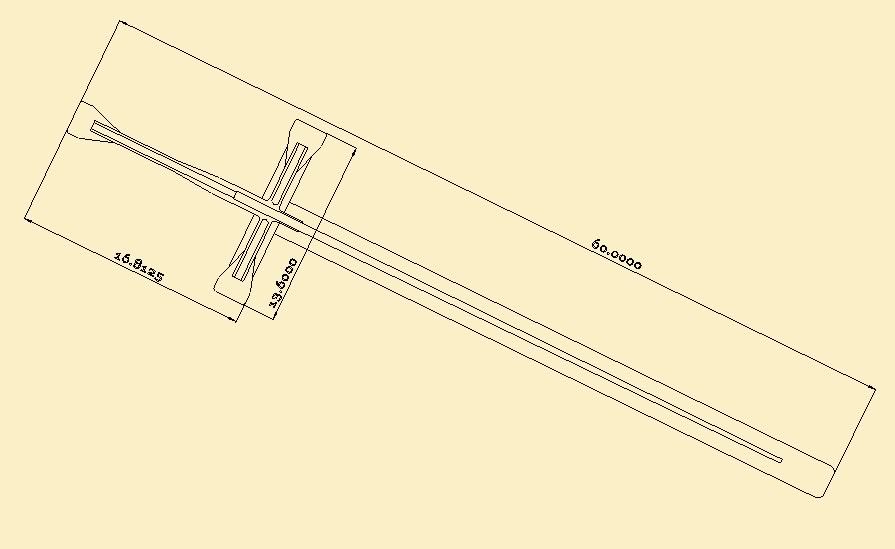 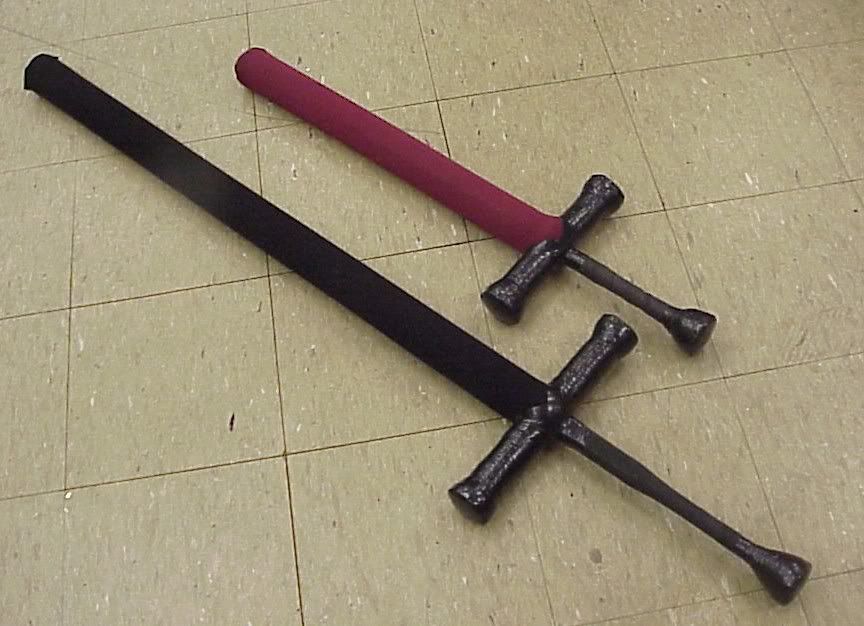 Short & reach above were made using machined plastic material for crosspiece core on the short, and handle & crosspiece core for the reach. Below is an easier method.  I used a CF golf shaft. The place on the golfshaft I wanted the cross guard to go measured .545, so I used a 17/32” (.531) reduced shank drill to make the hole in the 3/4” SCH-80 CPVC. Then I used a rawhide mallet to drive the core in to the proper depth. As an added measure, I used strapping tape (fiber reinforced tape, sometimes called filament tape) to bind the crossguard core to the golfshaft core. ½” strips (any width can be pulled into strips) from handle to rt-side guard, rt-side guard to bladeside core, bladeside core to left side guard and from left side guard back to the handle. I did this on each side. Tightly loop pieces of packing tape over each of the sides to keep the spirals of strapping tape down. 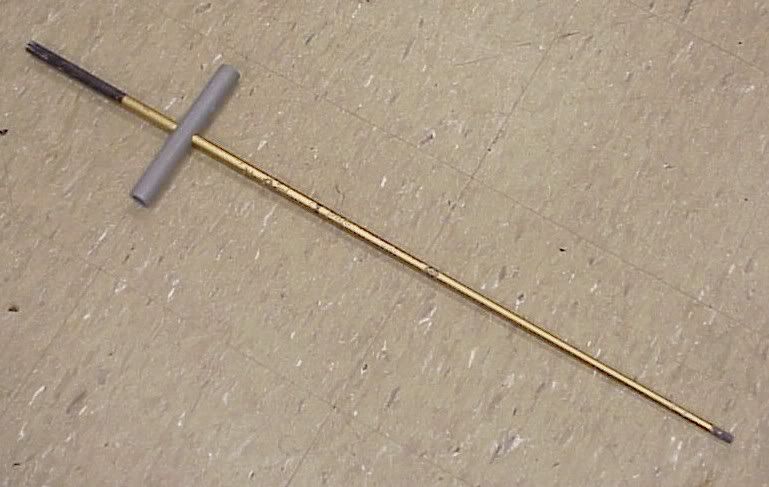 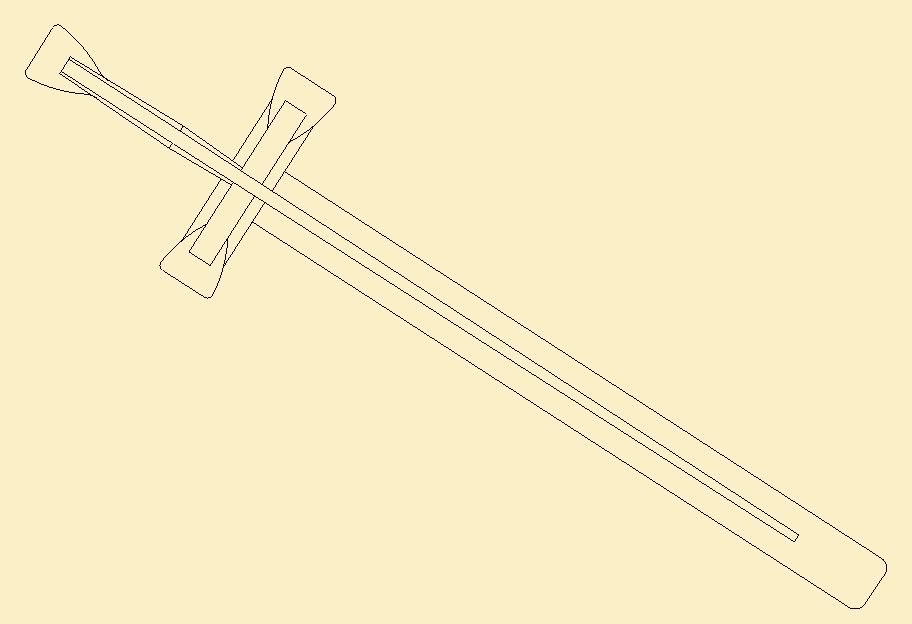 So far, the CPVC crosspiece cored sword is holding up nicely. It's only 4 months old tho.
|
|
  |
|
 |
|
Cava
|
 Posted: Posted: Thu Aug 19, 2010 3:51 pm |
|
Joined: Sun May 16, 2010 12:34 am
Posts: 17
|
|
Voshe those are beautiful!!! They make me drool like a kid in a candy store!!!!
|
|
  |
|
 |
|
Voshe
|
 Posted: Posted: Thu Aug 19, 2010 7:51 pm |
|
Joined: Thu Aug 09, 2007 3:43 pm
Posts: 105
|
|
  |
|
 |
|
aersixb9
|
 Posted: Posted: Thu Aug 19, 2010 10:59 pm |
|
Joined: Wed Jun 30, 2010 6:54 pm
Posts: 234
|
|
That was a beautiful post. I had a thought while looking at the pictures, was that the PVC pipe could potentially be replaced with any rigid tube or cylinder, or even a cube-rectangle rigid (also hopefully lightweight) object, simply by drilling a hole in the crosspiece to fit over the taper. The trick looks like measuring the circumfrence of the tapered golf club rod, and drilling a matching hole in whatever material (PVC pipe included) that you have! This solves a lot of the durability problems, as long as your cross piece is of a much higher diameter than your tapered golf club shaft, since downward movement will be blocked by the taper and the strength of the piece, and sideways movement will be held in place by the hole/shaft intersection. A bit of a binding agent, such as tape, caulk, epoxy, or glue, will then be much more effective with the strengths of the solid materials interwoven as shown in the above pictures, with upward pressure being a bit more rare and something to watch for, for that will place all the force on the binding agent and none on the materials! One option would be to use something strong like epoxy or gorilla glue (remember to coat both surfaces with small quantities of water!), making a ridge around the top of the shaft/hole to keep that in place, although the above crossguard design looks very practical, and with a different shaped piece could be modified into a full handguard simply by using a C-shaped piece with two holes drilled in it, then probably covered with foam. The piece could be made of anything, including non-rigid materials such as leather, to make a neat handguard, although carving a block of wood would work, as would carving a block of metal or even bending/moulding fiberglass cloth into a shape and mixing in some mixed fiberglass epoxy...although that could be glued directly on with the epoxy with similar strength, no drill needed.
|
|
  |
|
 |
|
Voshe
|
 Posted: Posted: Fri Aug 20, 2010 7:21 pm |
|
Joined: Thu Aug 09, 2007 3:43 pm
Posts: 105
|
From the beginning, I wanted a crossguard that would function like the real thing. Looks were always an afterthought somewhere behind safety. A substantial crossguard that would allow me to block & knock away even the heavier great weapons. The first ones were done in much the same way. 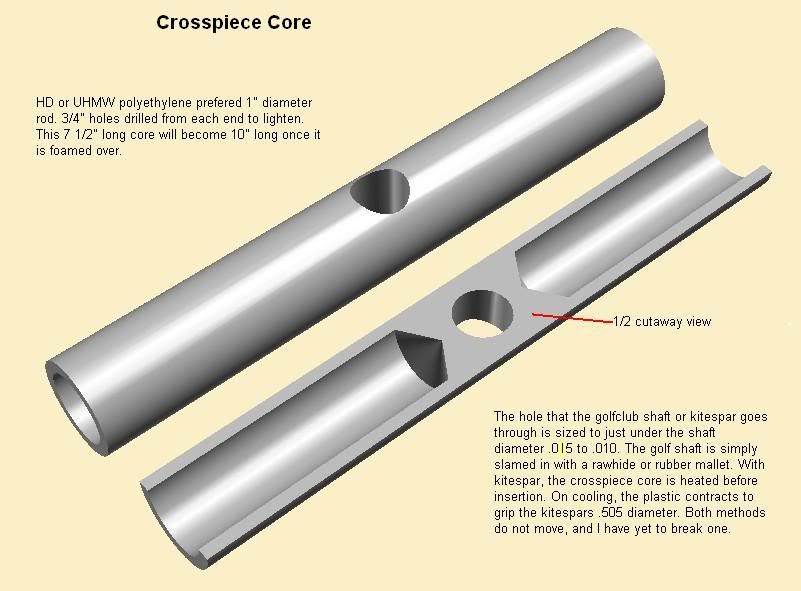 With these, I’ve even knocked away & run up those ginormous Texas warpoles. Have been asked “How can I make one of those?”, so I set out making one that didn’t require machine tools. I chose the CPVC for several reasons. Things like tensile strength, izod impact rating, weight, availability and flexibility were considered. I doubt that the CPVC core would hold up to too many full force blows from a Texas warpole (maybe none), but is has tested favorably against my little 7’+ great weapon pole (1”Dia. 1/8” wall thickness fiberglass tube core. A shield mover. Not light.). Yes, before anyone says it, I too seriously doubt that I’m the first to make crossguards in this way. One of the negatives to adding a crossguard is the weight that brings a swords balance back. I will gladly trade proper balance for increased defense, but that's just me. For a two handed long weapon, the added weight is not that important. Avoid sweeping quillions forward. This would allow you to capture an opponents weapon by turning your wrist as their weapon hits your crossguard. Grappling is what that's called, & it's against the rules.
|
|
  |
|
 |
|
aersixb9
|
 Posted: Posted: Sat Aug 21, 2010 5:23 am |
|
Joined: Wed Jun 30, 2010 6:54 pm
Posts: 234
|
|
You seem to be knowledgeable about CPVC, a topic that I know little about! I know regular PVC is a material that is too low density to be considered a good core, it's heavy for it's durability and rigidness. I have also heard CPVC is better? How durable and rigid is CPVC at different diameters, possibly compared to golf clubs (typically carbon fiber) and/or fiberglass? I think CPVC might make a good weapon core, especially if some is more rigid/durable at a given thickness than others...is CPVC a consistent material standard type, or is it some sort of numerical range? Also if you don't know that's okay too. A high quality CPVC or other synthetic rod or tube might allow for either a cheap core, or a light core that is very rigid and durable. Also I noticed that real swords are kind of heavy, so maybe having a bigger emphasis on heavier cores and more foam might be a good direction to go in? That makes parries more serious, and allows for more anticipation and also allows for safe hard swings due to extra foam that require actual swung parries to block without getting hit. That being said if it's too heavy it becomes unsafe at amtgard speeds due to momentum, same with being too rigid, so CPVC might be a good option, maybe at a .5" or .75" outer diamter for a 3 foot weapon? I might try and find some locally, although I know nothing about it, although reading about it here or elsewhere might help me too?
I also noticed you wedged it on by "underdrilling" the size of the hole. That sounds like a great way to keep it in place, by slightly compressing the material to "wedge" it on with a rubber hammer! I guess CPVC is a rubber and plastic like material, possibly even pure rubber (tree sap?) mixed with pure plastic (what's the natural/earthly/animal/plant/mineral source of plastic?) in a hot environment, then allowed to cool...probably like 85% plastic 15% rubber for regular PVC...this would allow for good compression under pressure, which should wedge it on there pretty solid so that the binding agent (tape,glue,etc) takes less of the force and holds up longer and harder.
|
|
  |
|
 |
|
Voshe
|
 Posted: Posted: Sat Aug 21, 2010 6:52 pm |
|
Joined: Thu Aug 09, 2007 3:43 pm
Posts: 105
|
|
CPVC is PVC that has undergone a post production process which exchanges the hydrogen in PVC with chlorine. In short, the alchemist took it through an extra step that makes it more ductile and flexible. Bending instead of breaking can be a good thing, but making a whole sword out of it may not be desirable. Even a short sword made with the 1/2" (Measured from inside diameter) CPVC would be kind of whippy. Heavy too. CPVC is far from an ideal material for crossguards. It's just a plastic that will do the job, and is widely available. PVC and most plastics are petrolium bassed. No trees involved.
|
|
  |
|
 |
|
Diestro
|
 Posted: Posted: Sat Aug 21, 2010 11:27 pm |
|
Joined: Sat Apr 22, 2006 9:55 pm
Posts: 638
|
|
Voshe, those look really great. I am skeptical of using friction to maintain the crossguard against a hard blow, though.
|
|
  |
|
 |
|
Users browsing this forum: No registered users and 11 guests |
| |
|
|
You cannot post new topics in this forum
You cannot reply to topics in this forum
You cannot edit your posts in this forum
You cannot delete your posts in this forum
You cannot post attachments in this forum
|

|
 |















